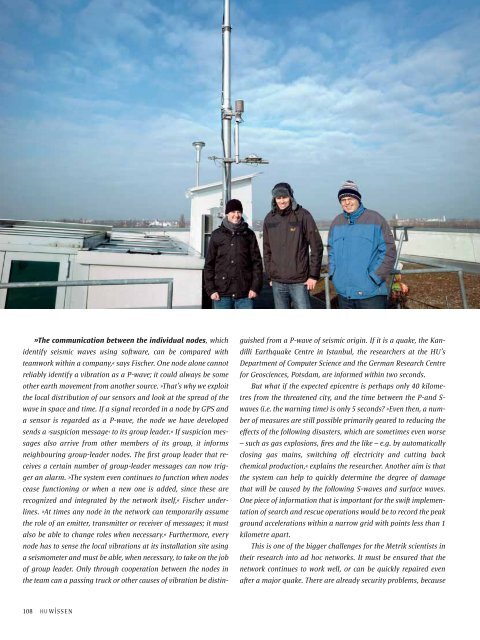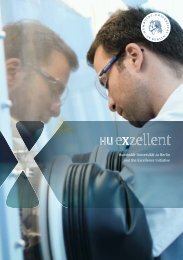hu wissen (pdf) - Exzellenzinitiative - Humboldt-Universität zu Berlin
hu wissen (pdf) - Exzellenzinitiative - Humboldt-Universität zu Berlin
hu wissen (pdf) - Exzellenzinitiative - Humboldt-Universität zu Berlin
Erfolgreiche ePaper selbst erstellen
Machen Sie aus Ihren PDF Publikationen ein blätterbares Flipbook mit unserer einzigartigen Google optimierten e-Paper Software.
»The communication between the individual nodes, which<br />
identify seismic waves using so� ware, can be compared with<br />
teamwork within a company,« says Fischer. One node alone cannot<br />
reliably identify a vibration as a P-wave; it could always be some<br />
other earth movement from another source. »That’s why we exploit<br />
the local distribution of our sensors and look at the spread of the<br />
wave in space and time. If a signal recorded in a node by GPS and<br />
a sensor is regarded as a P-wave, the node we have developed<br />
sends a ›suspicion message‹ to its group leader.« If suspicion messages<br />
also arrive from other members of its group, it informs<br />
neighbouring group-leader nodes. The fi rst group leader that receives<br />
a certain number of group-leader messages can now trigger<br />
an alarm. »The system even continues to function when nodes<br />
cease functioning or when a new one is added, since these are<br />
recognized and integrated by the network itself,« Fischer underlines.<br />
»At times any node in the network can temporarily assume<br />
the role of an emitter, transmitter or receiver of messages; it must<br />
also be able to change roles when necessary.« Furthermore, every<br />
node has to sense the local vibrations at its installation site using<br />
a seismometer and must be able, when necessary, to take on the job<br />
of group leader. Only through cooperation between the nodes in<br />
the team can a passing truck or other causes of vibration be distin-<br />
108<br />
guished from a P-wave of seismic origin. If it is a quake, the Kandilli<br />
Earthquake Centre in Istanbul, the researchers at the HU’s<br />
Department of Computer Science and the German Research Centre<br />
for Geosciences, Potsdam, are informed within two seconds.<br />
But what if the expected epicentre is perhaps only 40 kilometres<br />
from the threatened city, and the time between the P-and Swaves<br />
(i.e. the warning time) is only 5 seconds? »Even then, a number<br />
of measures are still possible primarily geared to reducing the<br />
eff ects of the following disasters, which are sometimes even worse<br />
– such as gas explosions, fi res and the like – e.g. by automatically<br />
closing gas mains, switching off electricity and cutting back<br />
chemical production,« explains the researcher. Another aim is that<br />
the system can help to quickly determine the degree of damage<br />
that will be caused by the following S-waves and surface waves.<br />
One piece of information that is important for the swi� implementation<br />
of search and rescue operations would be to record the peak<br />
ground accelerations within a narrow grid with points less than 1<br />
kilometre apart.<br />
This is one of the bigger challenges for the Metrik scientists in<br />
their research into ad hoc networks. It must be ensured that the<br />
network continues to work well, or can be quickly repaired even<br />
a� er a major quake. There are already security problems, because



